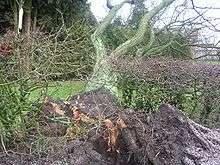Cyclone Gudrun
 Cyclone Gudrun in the North Sea | |
| Type |
European windstorm Extratropical cyclone |
|---|---|
| Formed | 7 January 2005 |
| Dissipated | 13 January 2005 |
| Lowest pressure | 960 mb (28 inHg) |
| Damage | £1.1 billion (2005 GBP) |
| Areas affected | United Kingdom, Ireland, Norway, Denmark, Sweden, Estonia |
Gudrun was a powerful storm which hit Denmark and Sweden on 8 January 2005 and Estonia on 9 January 2005. The name Erwin was chosen by the Free University of Berlin, while the storm was named Gudrun by the Norwegian Meteorological Institute and was the name used in Sweden. Sustained wind speeds of 126 km/h (78 mph) with wind gusts of 165 km/h (103 mph) were measured in Hanstholm, Denmark – the same strength as a Category 1 hurricane. At least 24 people died in the storm.
The storm caused significant financial damage in Sweden, where the forest industry suffered greatly from damaged trees, as more than 75,000,000 cubic metres (2.6×109 cu ft) of trees were blown down in southern Sweden. This resulted in Sweden at the time having the world's largest shortage of lumber.
About 415,000 homes lost power in Sweden and several thousand of these were without power for many days and even weeks in some cases, as about 10,000 homes were still without power after three weeks.[1] The death toll in Sweden was 20 victims, making it one of the biggest environmental disasters in Swedish history, while four were killed in Denmark and one in Estonia.
Meteorological history

On January 6, 2005, a low pressure system developed at a frontal zone south of Newfoundland.[2] It moved into the central North Atlantic and was named 'Erwin' by the Free University of Berlin.[2] Erwin strengthened rapidly and its pressure at the time of naming was 970mb.[2] Erwin moved quickly, and was already moving over Scotland and Northern Ireland on the 8th.[2] In the UK, temperatures were noticeably higher after the passing of Erwin.[2] On the 9th, Erwin had already moved into the Baltic Sea with a minimum central pressure of 960mb.[2] Over much of Central and Western Europe, temperatures were very mild.[2] The next day, weakening Erwin was over Western Russia with a pressure of 975mb.[2] Erwin began slowing down as it moved into Central Russia. On 13 January, Erwin dissipated over Russia.[2]
Byholma Wood Stockpile
The cyclone created the world's largest wood stockpile which Gizmodo lists as containing 1 million cubic meters of wood as of May 2012. In Sweden the total volume of wood from the trees struck down by the storm was about 75 million cubic meters. [3]
Carlisle and Cumbria flooding
In the UK the main impacts of the storm was flooding in Cumbria and Carlisle, where 1,800 homes were flooded in the city.[4]
See also
References
- ↑ "Gudrun - Januaristormen 2005". SMHI - Swedish Met Office. SMHI. Retrieved 7 December 2013.
- 1 2 3 4 5 6 7 8 9 "Life history of Depression ERWIN". FU-Berlin. Retrieved 1 January 2012.
- ↑ "The World's Largest Wood Stockpile Is Absolutely Insane". Gizmodo. Retrieved 14 May 2012.
- ↑ Harper, Mike (8 January 2015). "10 years on from the Cumbrian and Carlisle Floods of 2005". Environment Agency. Retrieved 19 January 2016.
- Danish page with wind speeds and satellite image - From the Danish Meteorological Institute (in Danish).
- Guy Carpenter report on Windstorm Erwin / Gudrun – January 2005 - A report for the insurance business with detailed information about the storm.
